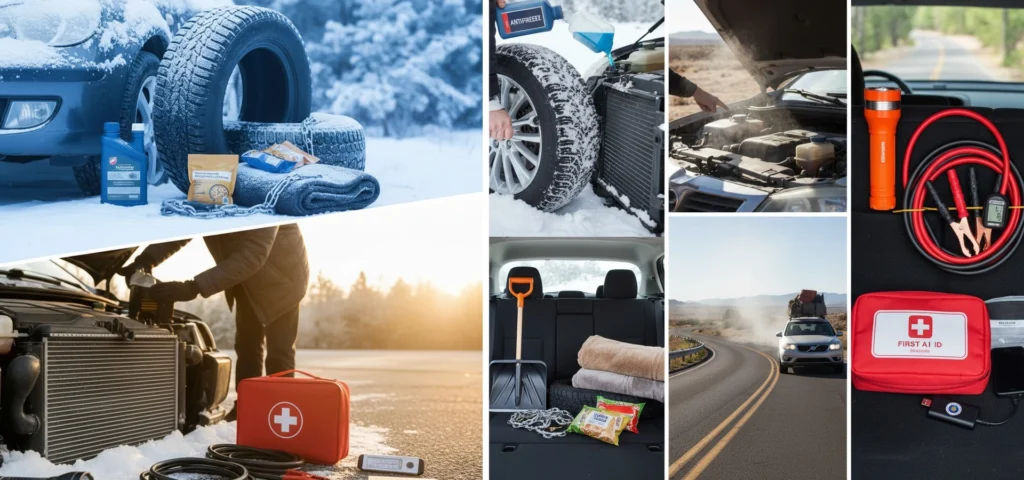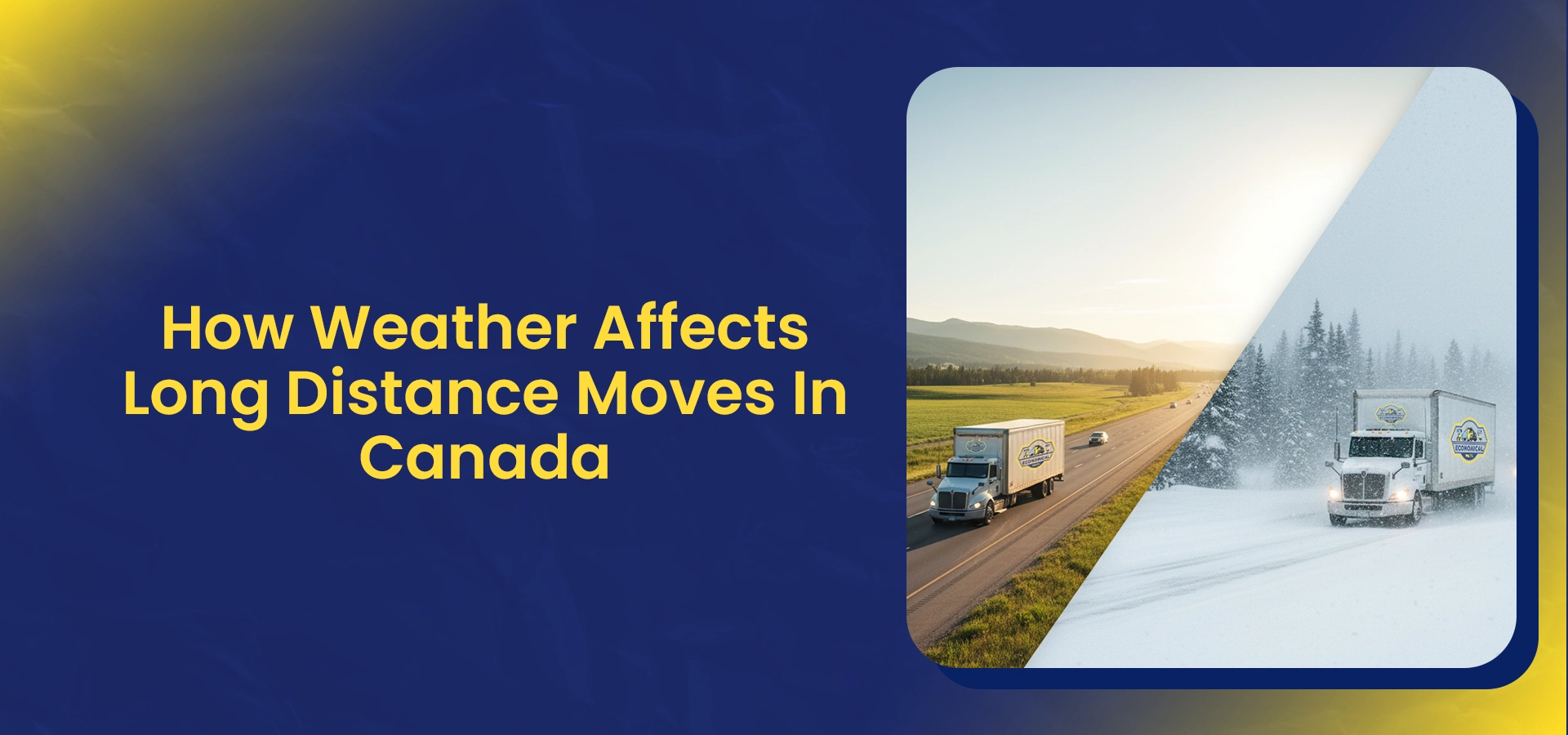Picture this– You are halfway through loading your moving truck in Ottawa when snow starts falling thick and fast, or you are driving through Alberta’s open plains and suddenly hit a wall of rain. That is Canada for you, breathtaking landscapes and completely unpredictable weather.
No matter if you are moving from Ontario to Alberta or from Nova Scotia to British Columbia, the weather can make or break your long distance moving in Canada. Snow, rain, heat, or fog, each season comes with its own challenges that affect travel time, packing choices, and even costs.
Our experienced team at Economical Movers knows firsthand how unpredictable weather can impact a move, and we’ve guided countless families across Ottawa through every kind of condition. We created this guide to help you understand how Canadian weather affects long distance moves. Thoughtful planning can keep your move on track, no matter the weather: rain, shine, or snow.
Why Weather Matters When Planning a Long Distance Move
Canada spans six time zones and multiple climate zones, meaning the weather in one province can be entirely different from another on the same day. Heavy snow in Manitoba, rain in Vancouver, or blazing sunshine in Calgary can all affect how you plan, pack, and travel.Bad weather doesn’t just slow you down; it can damage furniture, electronics, or delicate items, delay transport schedules, and even increase costs if extra handling or storage becomes necessary. That’s why being weather-aware is the first rule of long distance moving in Canada.
How Seasonal Weather Influences Long Distance Moving In Canada

Winter Moves In Canada (November to March): Challenges and Preparation Tips
Winter is the most demanding season for long distance moving in Canada. Snow, ice, and freezing temperatures make roads hazardous, and limited daylight reduces safe working hours.
How To Prepare For A Winter Move:
- Keep salt, shovels, and non-slip mats ready.
- Wrap electronics and wooden furniture with insulated blankets.
- Ensure the moving truck has winter tires and an emergency kit.
- Monitor local weather alerts and road closures.
- Reschedule if blizzards or freezing rain are expected.
Spring Moves In Canada (March to May): Dealing with Rain and Mud
Spring brings thawing snow, muddy driveways, and unpredictable rain, especially in rural or flood-prone areas.
How To Prepare For A Spring Move:
- Lay wooden planks or mats to avoid slipping.
- Protect boxes with waterproof containers or plastic wrap.
- Keep electronics and essential documents in sealed waterproof bags.
Avoid heavy rain days and start your long distance move preparation checklist early.
Summer Moves In Canada (June to August): Best Time For Long Distance Moving
Summer offers clear roads, longer daylight, and generally dry conditions, but high demand may affect availability.
How To Prepare For A Summer Move:
- Reserve your date 1–2 months in advance.
- Start loading early to avoid mid-day heat.
- Keep water handy and protect heat-sensitive items from direct sun.
- Monitor wildfire and air quality alerts if travelling through affected areas.
Fall Moves In Canada (September to October): Mild Weather With Occasional Surprises
Fall has moderate temperatures and fewer scheduling conflicts, but may bring early frost or sudden rain.
How To Prepare For A Fall Move:
- Use moisture-resistant packing materials.
- Track weather forecasts daily.
- Plan for shorter daylight and load early in the morning.
- Keep extra tarps or covers ready for rain.
How To Protect Your Belongings From Weather Damage
Your items face their own challenges on the road. Humidity, freezing air, and sudden temperature shifts can affect them in ways you might not expect.

When unloading during rain or snow, lay down floor mats to prevent moisture and mud from damaging your new home’s flooring.
How To Prepare Vehicles and Equipment For the Weather

Long drives across provinces mean your vehicle must handle multiple conditions in a single trip.
- For winter travel: Install winter tires and check antifreeze levels. Carry traction aids, blankets, and emergency food supplies.
- For summer travel: Check cooling systems and avoid overloading to prevent overheating.
- Year-round essentials: Include a flashlight, first aid kit, jumper cables, tire gauge, and portable phone charger.
Doing a full maintenance check before departure saves time and prevents mid-route breakdowns that could leave you stranded in poor weather.
How Moving Companies Can Help You Move During Bad Weather
Reputed moving companies working for years are skilled at managing moves through rain, snow, and extreme temperatures. They use weatherproof covers, sturdy packing materials, and proper equipment to protect your belongings throughout the journey. Experienced movers also know how to handle loading and unloading safely on wet or icy surfaces, reducing the risk of damage or delays.
Many companies monitor weather forecasts and adjust their plans to ensure a secure and timely move. Choosing a reliable team with proven expertise can make all the difference, and Economical Movers is always ready to help you move safely in any weather.
Frequently Asked Questions
1. How can I Decide Whether To Move Or Postpone Due To Weather?
If forecasts predict severe storms, ice, or flooding, it’s safer to delay by a day or two. The short wait is worth avoiding costly damage or danger.
2. How Do I Protect Electronics From Extreme Temperatures?
Let them adjust to room temperature before turning on. Condensation inside cold devices can cause short circuits.
3. What’s The Safest Season For A Long Distance Move?
Summer is generally the most reliable, but early fall also offers mild temperatures and fewer crowds.
4. How Can I Keep Boxes Dry During Rain or Snow?
Load weather sensitive items first, cover walkways with tarps, and seal every box with packing tape to block moisture.
5. What Should I Include In A Weather Ready Checklist?
Protective wraps, waterproof containers, vehicle emergency kits, alternate routes, and local weather apps should all be part of your long distance move preparation checklist.
Conclusion: Smart Planning Makes Every Move Weather Proof
Weather may be beyond our control, but preparation isn’t. By planning around seasonal conditions, monitoring forecasts, and protecting your belongings and route, you can make your move safer and smoother, no matter what the sky looks like.
When it comes to long distance moving in Canada, flexibility, awareness, and a little extra planning are your best allies. Pack wisely, check conditions early, and you’ll not only protect your possessions but also enjoy a smoother journey to your new home in any season, across any province.



